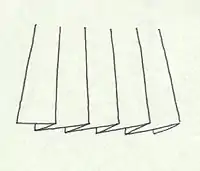

In geometry, a pleated surface is roughly a surface that may have simple folds but is not crumpled in more complicated ways. More precisely, a pleated surface is an isometry from a complete hyperbolic surface S to a hyperbolic 3-fold such that every point of S is in the interior of a geodesic that is mapped to a geodesic. They were introduced by Thurston (1980, 8.8), where they were called uncrumpled surfaces.
The Universal Book of Mathematics provides the following information about pleated surfaces:
It is a surface in Euclidean space or hyperbolic space that resembles a polyhedron in the sense that it has flat faces that meet along edges. Unlike a polyhedron, a pleated surface has no corners, but it may have infinitely many edges that form a lamination.
References
- Canary, R. D.; Epstein, D. B. A.; Green, P. (2006) [1987], "Notes on notes of Thurston", in Canary, Richard D.; Epstein, David; Marden, Albert (eds.), Fundamentals of hyperbolic geometry: selected expositions, London Mathematical Society Lecture Note Series, vol. 328, Cambridge University Press, ISBN 978-0-521-61558-7, MR 0903850
- Thurston, William (1980), The geometry and topology of three-manifolds, Princeton lecture notes